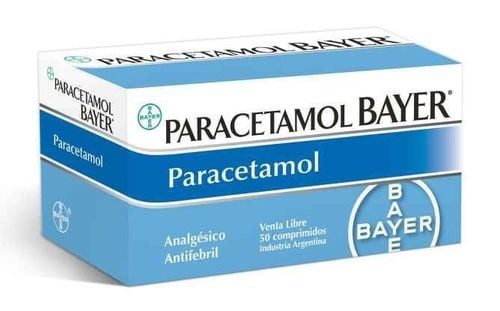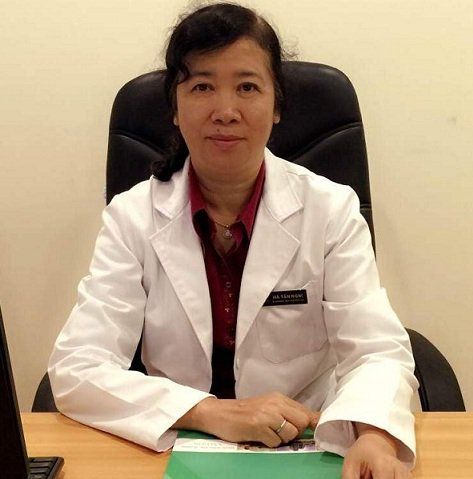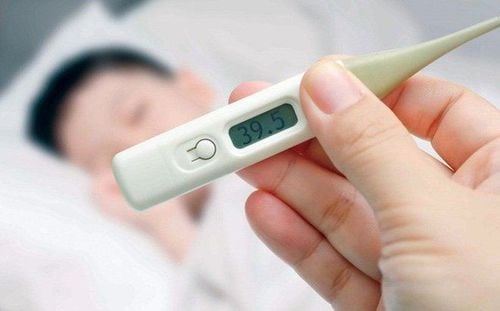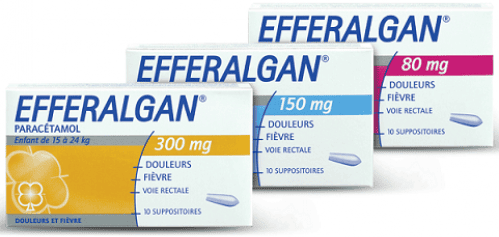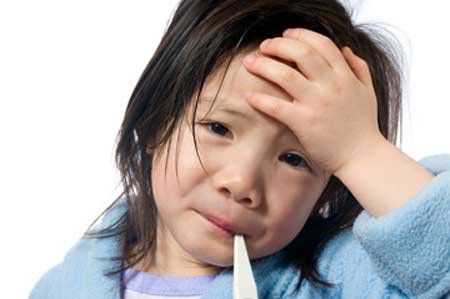This is an automatically translated article.
The article was professionally consulted by Specialist Doctor II Cao Thi Thanh - Pediatrician - Department of Pediatrics - Neonatology - Vinmec Hai Phong International General Hospital. Dr. Thanh has worked for 25 years in the treatment of neonatal pediatric diseases.Fever occurs when the baby's body temperature is higher than normal. To avoid dangerous complications caused by fever, parents need to know how to measure their baby's temperature and how to appropriately handle a child's fever.
1. What is a fever?
Body temperature is controlled by the hypothalamus of the brain. The hypothalamus regulates body temperature by balancing the production of heat by the muscles and liver with heat loss through the skin and lungs. Fever occurs when the hypothalamus raises body temperature. Fever is usually caused by the immune system's response to infectious agents such as bacteria or viruses.When you have a fever, your body temperature will be over 38oC in the rectum, over 37.5oC in the mouth, over 37.2oC in the armpits and over 38oC in the ears.
Bacterial infections are the most common cause of fever. Besides, viral and bacterial diseases such as diarrhea, colds, ear infections, acute laryngitis and bronchiolitis... are the leading causes of fever. Some vaccines can cause fever, and the duration of the fever varies depending on the vaccine used.
Trắc nghiệm: Sự phát triển tinh thần, vận động của bé thế nào là đúng chuẩn?
Khi nào bé biết nói, biết hóng chuyện hay biết cầm cốc là "đúng chuẩn"? Điểm xem bạn biết được bao nhiêu mốc phát triển tinh thần, vận động "đúng chuẩn" của bé nhé!The following content is prepared under supervision of Thạc sĩ, Bác sĩ y khoa, Ma Văn Thấm , Nhi , Phòng khám Đa khoa Quốc tế Vinmec Dương Đông(Phú Quốc)
2. How to measure a child's temperature
There are many methods of measuring the body temperature of children. Usually rectal temperature is the most accurate method. However, parents can also use oral temperature for children over 4 years old, ear temperature for children over 6 months old. Taking temperature under the armpit is the least accurate method but very convenient, especially for babies under 3 months old. If the temperature in the armpit is below 37.2oC, parents should use the rectal method of measuring body temperature.Parents should use electronic thermometers instead of mercury thermometers because it is less expensive, more common and safer. Mercury is very toxic, and if the thermometer is broken, it can be dangerous for young children. Here are the methods of measuring body temperature for children:
2.1 Measure body temperature in the armpit
Keep the thermometer in the child's armpit (need to dry the armpit before measuring). Ask your child to hold the thermometer by pressing his elbow to his chest for about 4-5 minutes.
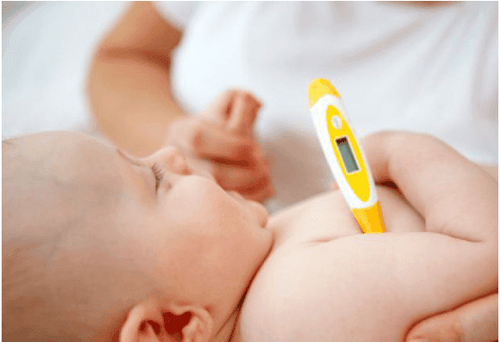
2.2 Oral body temperature measurement
This method should not be performed when the child has eaten or drank hot food within 30 minutes. When doing, parents do the following:Wash the thermometer with cold water and soap and then rinse with water. Place the tip of the thermometer under the child's tongue, ask the child to hold the thermometer with his lips, keeping his lips closed around the thermometer. Keep the thermometer in place: With a mercury thermometer, children need to hold it for about 3 minutes and with an electronic thermometer, children only need to hold it for less than 1 minute.
2.3 Measuring body temperature at the ear
This method does not apply to children under 6 months of age. If your child has just been outside in the cold, you need to wait at least 15 minutes before taking the temperature. Ear canal and ear disease will not affect the display of the child's body temperature. Ear temperature measurement is performed as follows:Pull the child's outer ear before inserting the thermometer. Hold the thermometer probe in your ear for 2 seconds.
2.4 Rectal body temperature measurement
For infants and young children to lie face down in the lap of adults. Apply a little lubricant (e.g. vaseline) to the end of the thermometer. Gently place the thermometer in the child's anus until the silver tip of the thermometer is no longer visible (about 0.6 - 1.3cm inside the anus). Keep the thermometer in place: Wait about 2 minutes for a mercury thermometer and 1 minute for an electronic thermometer.
3. When should the child be taken to the hospital?
Fever can play a role in fighting infection for the body. When taking a child's temperature indicates a fever, parents need to consider the symptoms that accompany a child's fever. In most cases, fever can be monitored and treated at home.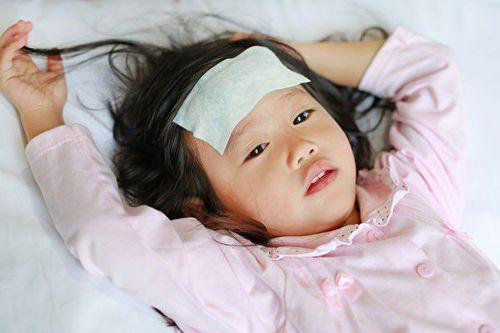
Playing, awake, crying loudly, not crying for a long time. The skin is ruddy. No difficulty breathing. Wet hands and feet. The body shows no signs of dehydration. On the contrary, parents should quickly take the child to the hospital if the fever is accompanied by symptoms such as:
Shortness of breath: Rapid breathing, stridor, chest indrawing. Cold hands and feet. Convulsions. Fever, inflexibility. The child is dehydrated (sunken eyes, eager to drink water, little urine). Fever for more than 7 days even if it is mild. Fever with erythema at the same time. Fever above 38oC for children under 3 months old, over 39oC for children 3-24 months old, 40oC in all age groups. In addition, parents should also take the child to the hospital if the child under 24 months has a fever for more than 2 days, and the child over 2 years old has a fever for more than 3 days. The child has a recurring fever. Children with underlying diseases such as cancer, heart disease, lupus or sickle cell,...
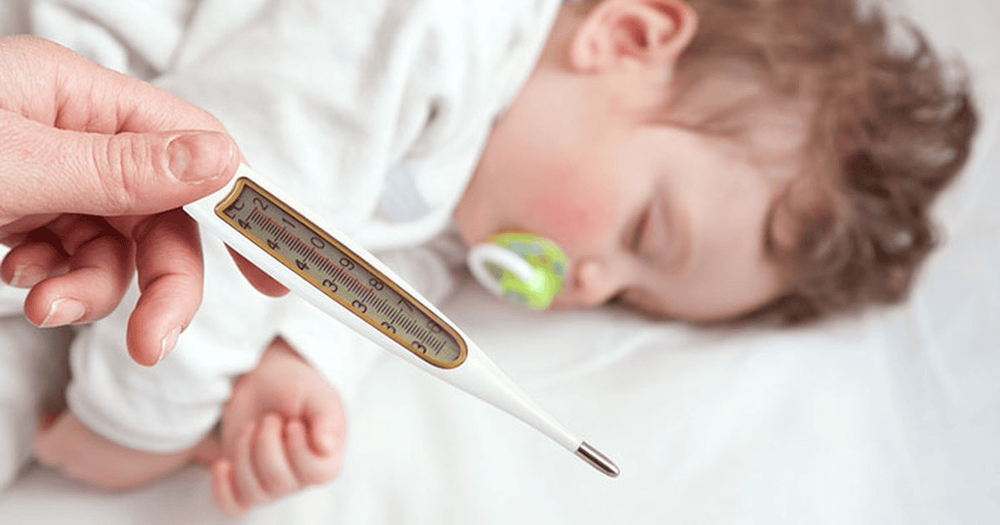
4. What to do if the child has a fever?
When measuring the baby's temperature and detecting that the baby has a fever, parents should handle the following:4.1 Use of antipyretics
Antipyretic drugs are used in the following cases: Children with fever from 38.5oC or higher accompanied by symptoms such as fussiness, difficulty sleeping, anorexia; Fever from 38oC or higher with a history of convulsions, heart/lung disease,... When using antipyretic drugs early and correctly, children rarely have a fever above 39oC with convulsions - in case it is necessary to fight convulsions and reduce fever urgently .Medicines that are effective in reducing fever in children are Ibuprofen or Paracetamol (Acetaminophen). These drugs make the child more comfortable, reducing the child's body temperature to about 1-1.5oC.
Paracetamol (Acetaminophen) can be used every 4-6 hours as needed at a dose of about 10-15mg/kg/time. If the child's temperature is still high and the child is over 6 months old, Ibuprofen can be used instead or in combination with Paracetamol (Acetaminophen), the dose is 5-10mg/kg orally every 6-8 hours.
Note:
It is less safe to use both Paracetamol (Acetaminophen) and Ibuprofen than taking one drug alone. Antipyretics should only be used when needed and should be discontinued when fever and symptoms are gone. Aspirin should not be given to children because it can cause serious conditions such as Reye's syndrome.
4.2 Cooling for children
After measuring the child's body temperature, it is found that the child has a fever above 40oC, fever with convulsions, does not respond to antipyretic drugs, parents should wipe cool, use a towel to cover the child's body with warm water about 29 - 32oC, especially in the forehead and armpits. , neck, groin. Your baby will feel cooler as the water evaporates through the skin. The cool compress should be combined with antipyretic when the child cannot tolerate the medicine.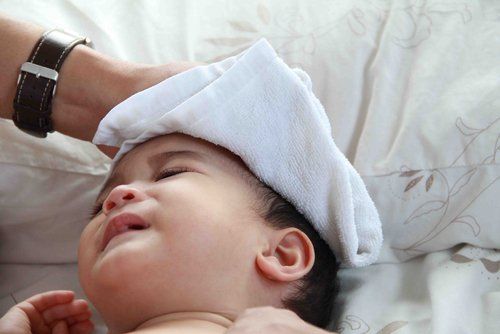
Avoid rubbing alcohol with alcohol because alcohol vapor can be absorbed through the skin and lungs, causing adverse effects on the health of the child. Do not apply lemon when you cool your baby because it can cause skin damage. Do not wipe with ice water because it will increase the child's body temperature.
4.3 Notes when taking care of children with fever
Fever increases the risk of dehydration in children. Therefore, to reduce this risk, parents should encourage their children to drink enough water. Drinks such as milk and water need to be supplemented with the necessary amount. If the child refuses to drink water, milk or cannot, parents should consult a pediatrician. Pay attention to adding nutritious foods to your baby, divide them into many small meals during the day, and give them lots of fruits and vegetables to supplement vitamins. When the baby has a fever, parents should dress the baby in loose, comfortable clothes, not too warm. Fever causes fatigue and discomfort for children. Therefore, when the child has a fever, parents should encourage the child to rest more. Children can return to school and participate in other activities 24 hours after their temperature returns to normal. Immediately return to the doctor if the child does not have a fever after 2 days of treatment or the disease shows signs of worsening. Children with high fever with many unusual symptoms such as convulsions, rashes, ... are extremely dangerous, if not handled promptly, they will cause many complications for cardiovascular, neurological and even death. Therefore, when your baby has the above symptoms, you should take him to a reputable medical facility immediately.
Pediatrics Department, Vinmec International General Hospital is well invested in personnel, technology and equipment, bringing satisfaction to customers. Currently, there are very few hospitals in Vietnam that have a full range of doctors specializing in cardiology, neurology, respiratory, urology, gastroenterology, nutrition... right at the pediatric department. If the baby has a high fever with complications, it will be diagnosed and treated immediately at the Pediatric Department, shortening the treatment time and bringing better results. The team of doctors and nurses are all highly qualified and experienced, bringing to the baby the most effective and latest treatment regimens in the world.
If you have a need to examine your baby, please register directly at the website or contact the hotline system for detailed advice.
Please dial HOTLINE for more information or register for an appointment HERE. Download MyVinmec app to make appointments faster and to manage your bookings easily.






